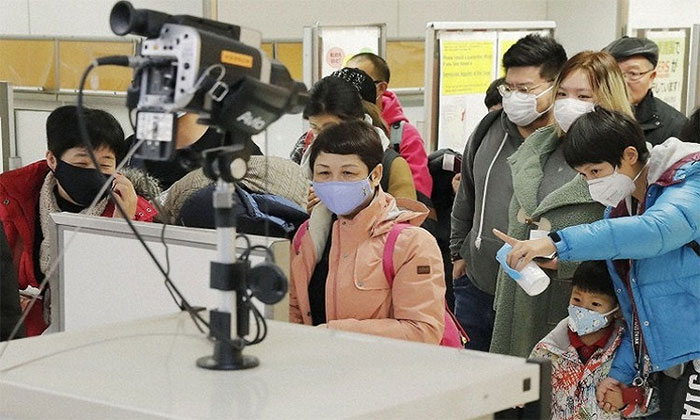How can corona virus spread on airplanes?
The corona virus can be transmitted to other passengers through droplets or mucus and through contact surfaces such as chairs or dining tables.
When a disease outbreak, of course we need to be careful when boarding. The situation is even more alarming when two dangerous viruses appear at the same time. People around the world are threatened by the new corona virus in China and spread to nearly 15 other countries, including the United States.
Although many major airports begin checking passengers through doors to prevent corona virus, this move may not be enough to reassure those who need to fly. We can avoid getting infected from a person who sneezes in line, but when we sit still in the cabin with the seatbelt tight, we are forced to leave the fate alone.
While there is still much to be learned about Wuhan pneumonia, scientists have a certain understanding of similar coronavirus and other respiratory diseases such as seasonal flu.

Passengers returning from Wuhan are tested for body temperature by a thermal scanner at Narita Airport on January 23, 2020.(Photo: AP).
How is respiratory disease spread in general?
If you've ever used your hands to cover your mouth when sneezing or avoiding a colleague who is constantly coughing, you may have a rough idea of how the disease spreads. When an infected person coughs or sneezes, they spit out saliva, mucus, or other body fluids. If you come in contact with one of them, you are also at risk.
Droplets or tiny mucus are not affected by the airflow in the space, but near the place where they shoot out. According to Emily Landon, director of antibacterial and infectious control management at the University of Chicago School of Medicine, the hospital hospital's flu prevention guidelines make it clear that we can be infected by standing close to patients within 2 meters from 10 minutes. and up .
Respiratory illnesses can also spread on surfaces where droplets fall like airplanes or table trays. The amount of time they exist depends on the nature of the droplet and the surface of contact, such as saliva or mucus, thick or hollow. Viruses have a significant difference in surface time, from hours to months.
Researchers have also found evidence that the virus can pass through the air through microscopic dry particles called aerosols. But according to Arnold Monto, professor of epidemiology and public health at the University of Michigan, it is not the main mechanism of transmission of the virus. Viruses often prefer high humidity environments and many species will weaken if exposed to dry conditions for long periods.
Note when flying
According to the World Health Organization (WHO), we can contact infected people within two rows of seats. But people often do not sit still during the flight, especially flights that last several hours. They often go to the toilet, stretch their legs and touch objects in the overhead luggage compartment. In fact, during the 2003 outbreak of the Severe Acute Respiratory Syndrome (SARS) due to the corona virus, a passenger traveling from Hong Kong to Beijing infected people who sat farther than two rows of seats. The Medical Journal emphasized that WHO criteria "will miss 45% of SARS patients".
Starting from the above case, a group of public health researchers conducted a study to find out how randomly moving around an aircraft cabin can change a passenger's susceptibility. Mortality is the number of deaths compared to the number of infected cases. Despite being considered a global disaster, seasonal flu has a relatively small death rate, at about 0.1%. In 2018 and 2019, seasonal flu affected 35.5 million people in the United States, leaving 490,000 hospitalized and 34,200 dead.
Mortality also helps to explain why public health authorities must warn of corona virus outbreaks. SARS has a mortality rate of 10%, 100 times higher than seasonal flu. The current mortality rate of nCoV virus is nearly 3%, equivalent to the Spanish flu pandemic of 1918. If SARS or Wuhan pneumonia spread to millions of people, the number of deaths would be very large. Unlike seasonal flu, we are at risk from the nCoV virus because no one has ever been infected with this virus before and there is no specific treatment like a vaccine.
- Viet Duc Hospital Doctor gave 10 notes to people about the situation of the widespread Corona virus disease
- Going to school, going to work again after Tet, the doctor noted 12 points to limit the transmission of Corona virus
- The Ministry of Health is only a way away from strange pneumonia outbreaks in China
- Publish the first image of the Corona virus
- China suddenly announced that not everyone infected with the Corona virus had signs of fever
- Notes on prevention and protection of Corona virus
- Where do people who show signs or infection of corona virus will be treated?
- WHO warns corona virus is likely to cause pandemic
- Corona virus can spread widely on people
- Many people are confused about Wuhan virus and Corona beer
- MERS-CoV virus is less likely to spread into epidemics
- Corona virus can be transmitted from person to person within 15 minutes
- How to prevent and protect young children from the risk of coronary virus infection
- How to directly update the situation of Wuhan virus
- Detect 3 Vietnamese who are positive for corona virus
- Beijing uses anti-HIV drugs to treat corona virus
- WHO declares the corona virus outbreak as a global emergency
 13 causes of non-itchy rash
13 causes of non-itchy rash How the mouse with human ears changed the world?
How the mouse with human ears changed the world? The truth about 'fried rice syndrome!
The truth about 'fried rice syndrome! What is dental implant?
What is dental implant?